_________________
REIMAGINING THE RENAISSANCE
Until 13th April 2025
_________________
I appreciate that this exhibition has not long to run but try and get to Adelaide to see it -it will reward you many times over!
My passion for art began with the selection of Art History 101 at Auckland University to test the ‘genuine interest in art’ waters; begun not long before at an exhibition of work by Hugh Ramsay (1877 – 1906), at the NGV in Melbourne; consequently Ramsay has become one of my favourite artists.
Art History 101 necessarily includes a paper on the Renaissance. For me discovering the richness of the Renaissance period (in all its forms) was akin to being freed from a straight jacket of mediocrity that had come to represent my life. I was enthralled from the moment I first saw Giovanni Bellini’s San Zaccaria Alterpiece.(1)
However, and conceivably, the default image for the everyday person in the art world is Leonardo da Vinci’s (1452 – 1519) Mona Lisa and as such the Renaissance is arguably the most recognised period of art for ordinary people across the globe. Those ignorant of art have generally heard of the Mona Lisa, and thus by association, also the Renaissance whether they realise that or not.
Moreover the Renaissance is replete with some of the world’s greatest and most recognised painters, sculptors and architects: Raphael, Michelangelo, Leonardo de Vinci, Donatello, Brunelleschi and Botticelli to name a few
_________________
The European Renaissance witnessed profound artistic and cultural change, a rebirth following the devastating loss of knowledge in the so-called ‘Dark Ages’. During this new and transformative period in art, notions of form, colour and perception changed fundamentally and an artistic revolution was born, most notably in the understanding of composition and realism and the rise of humanism.
Throughout art history, the Italian Renaissance has taken centre stage and is regarded as one of the most important periods of artistic revolution and development, often overshadowing the artistic developments simultaneously occurring in other parts of Europe.
Text AGSA
_________________
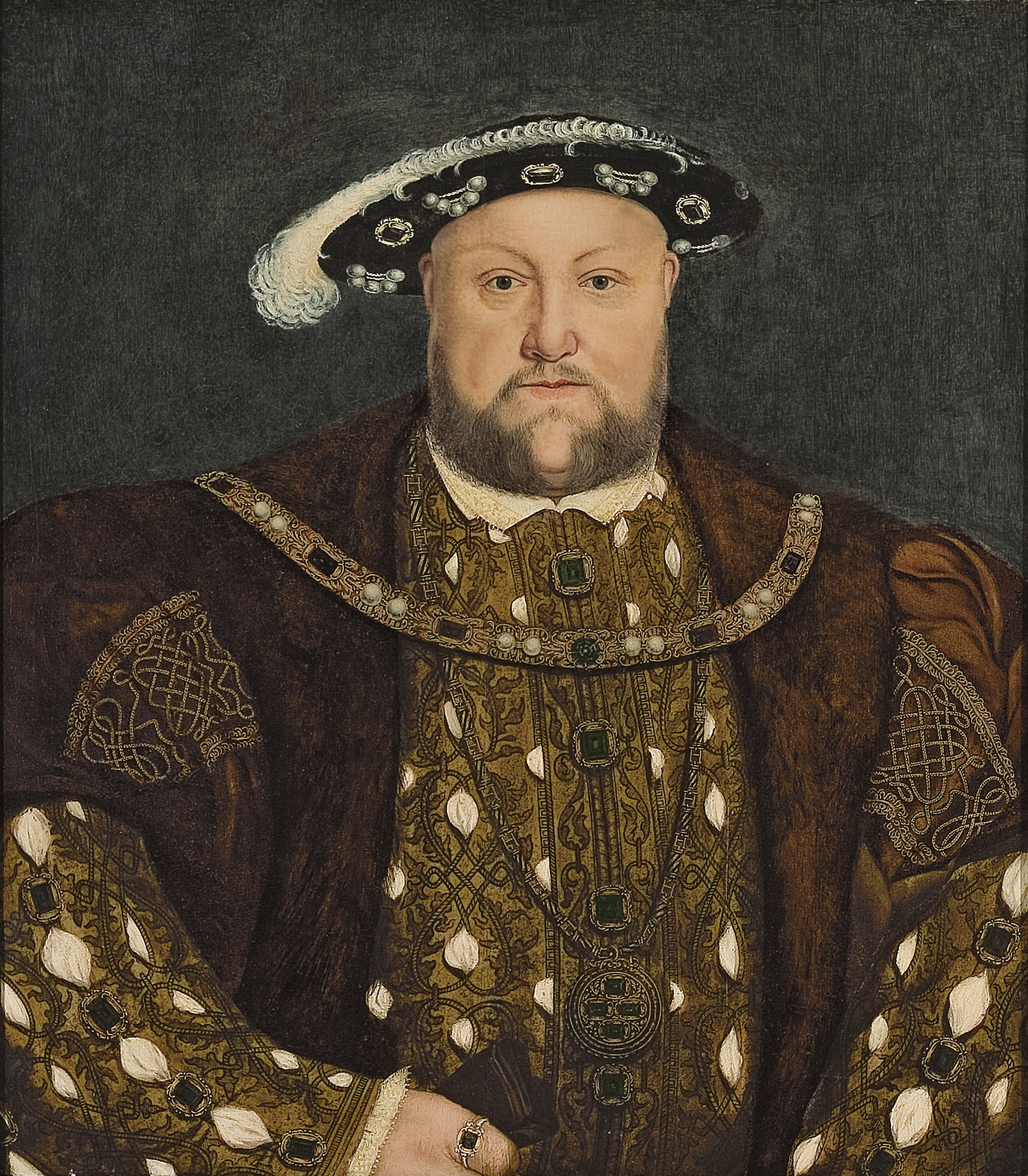 After Hans Holbein The Younger, born Ausburg, Germany 1497, died London 1543, King Henry VIII, c 1540s, London, oil on wood panel, 65.0 x 57.5 cm, 89.5 x 81.5 x 9.0 cm (frame), Collection of Art Gallery of South Australia, Adelaide
After Hans Holbein The Younger, born Ausburg, Germany 1497, died London 1543, King Henry VIII, c 1540s, London, oil on wood panel, 65.0 x 57.5 cm, 89.5 x 81.5 x 9.0 cm (frame), Collection of Art Gallery of South Australia, Adelaide
Clarifying, Hans Holbein (1497 – 1543), is considered one of the greatest portraitists of the sixteenth century, seconded to the English ruling elite, producing images that came to define their public personas, both in their own time and in later centuries. He spent two periods of his life in England (1526-8 and 1532-43), portraying the nobility of the Tudor court.
Holbein’s famous portrait of Henry VIII (London, National Portrait Gallery) dates from the second of these periods. Beyond portraiture, Holbein was also a very versatile artist who turned his hand to religious paintings, frescoes, jewelry and clothing design, and book illustrations throughout his lifetime. Predominantly linked to the Northern Renaissance, Holbein also incorporated elements and ideas from the Italian Renaissance into his work to create sumptuous and detailed images with their own unique appearance. Holbein is particularly well known for his mastery of light and texture, and his exquisite portrayals of fabric, fur, and glass are a testament to his skill.
__________________
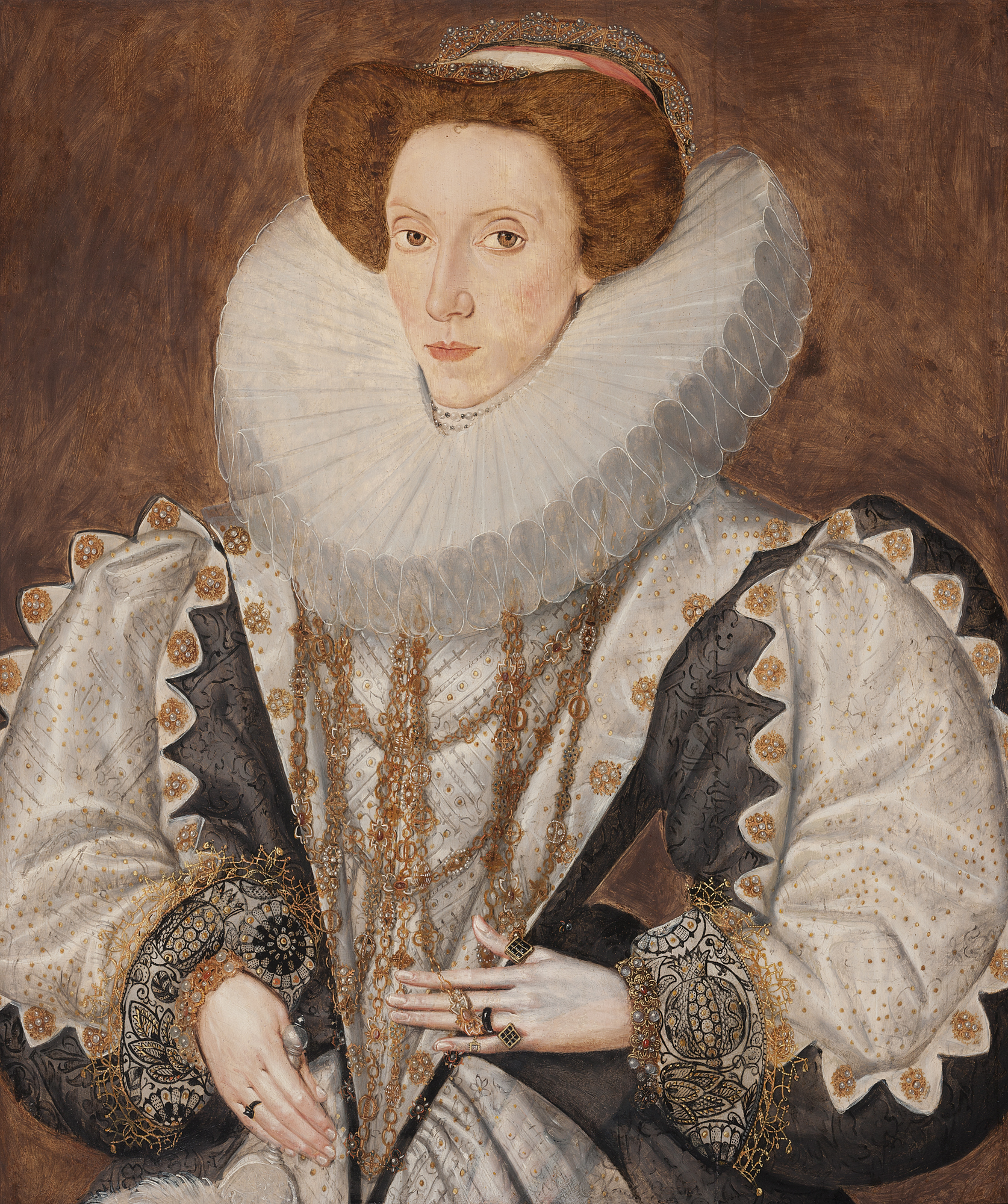
George Gower, born c.1540, died 1596, Portrait of a lady, c 1590, Britain, oil on wood panel, 78.1 x 64.7 cm, 94.7 x 82.0 x5.8 cm (Frame); Collection of Art Gallery of South Australia, Adelaide
_________________
Little is known about his (George Gower’s) early life except that he was a grandson of Sir John Gower of Stettenham, Yorkshire. Gower was appointed to the position of Serjeant Painter to Queen Elizabeth in 1581. This allowed him to paint most of England’s aristocracy. The post also made him responsible for painted decoration at the royal residences, and on coaches and furniture.
__________________
Albrecht Durer (1471 – 1528) is acknowledged as one of the finest print makers of the late 15th and early 16th centuries.
Dürer’s Melencolia I is one of three large prints of 1513 and 1514 known as his Meisterstiche (master engravings). The other two are Knight, Death, and the Devil (43.106.2) and Saint Jerome in His Study (19.73.68). The three are in no way a series, but they do correspond to the three kinds of virtue in medieval scholasticism–moral, theological, and intellectual–and they embody the complexity of Dürer’s thought and that of his age.
Image: Knight, death and devil, 1513, Nuremberg, Bavaria, Germany, engraving on paper, 24.4 x 18.8 cm (plate & sheet); Collection of Art Gallery of South Australia, Adelaide
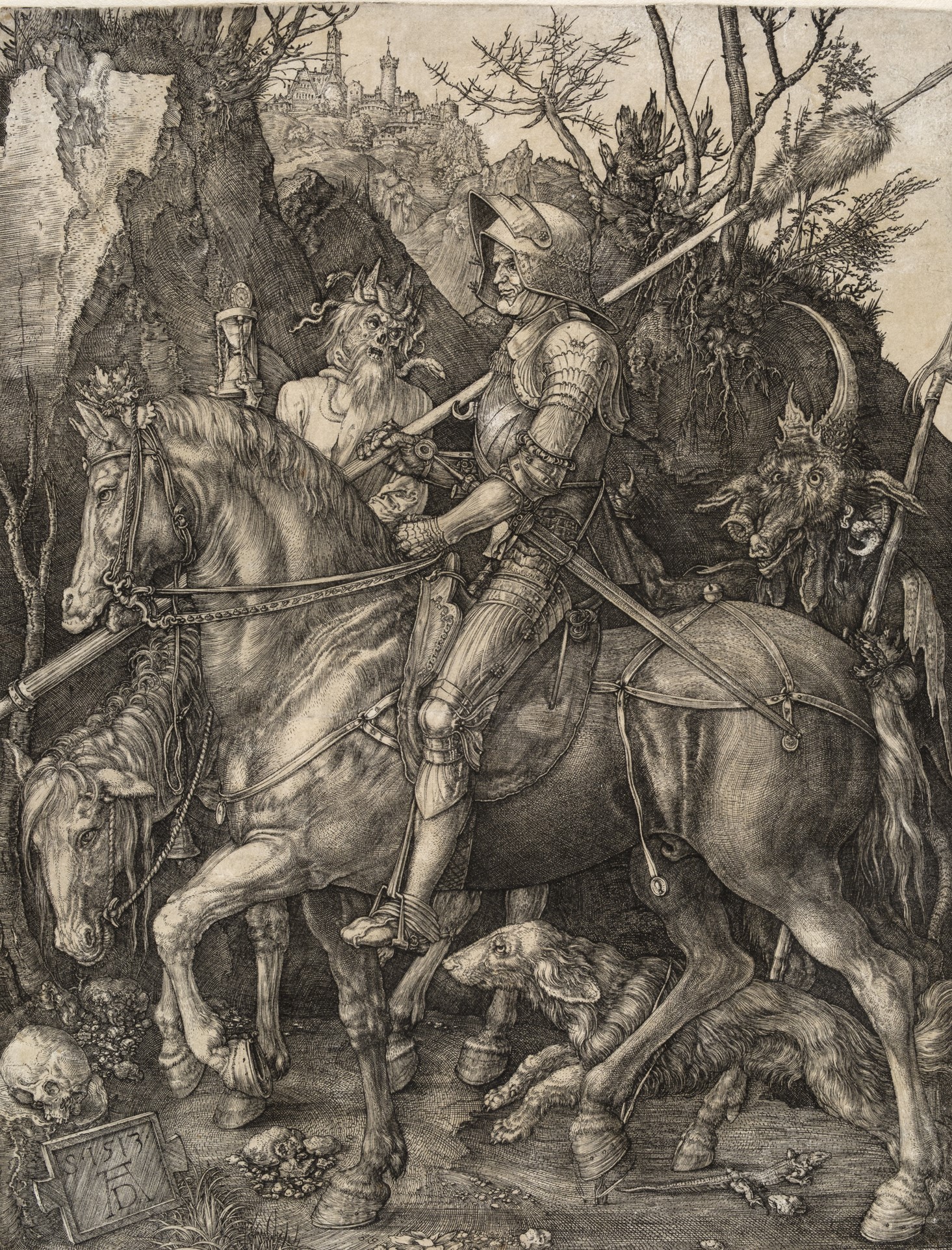
__________________
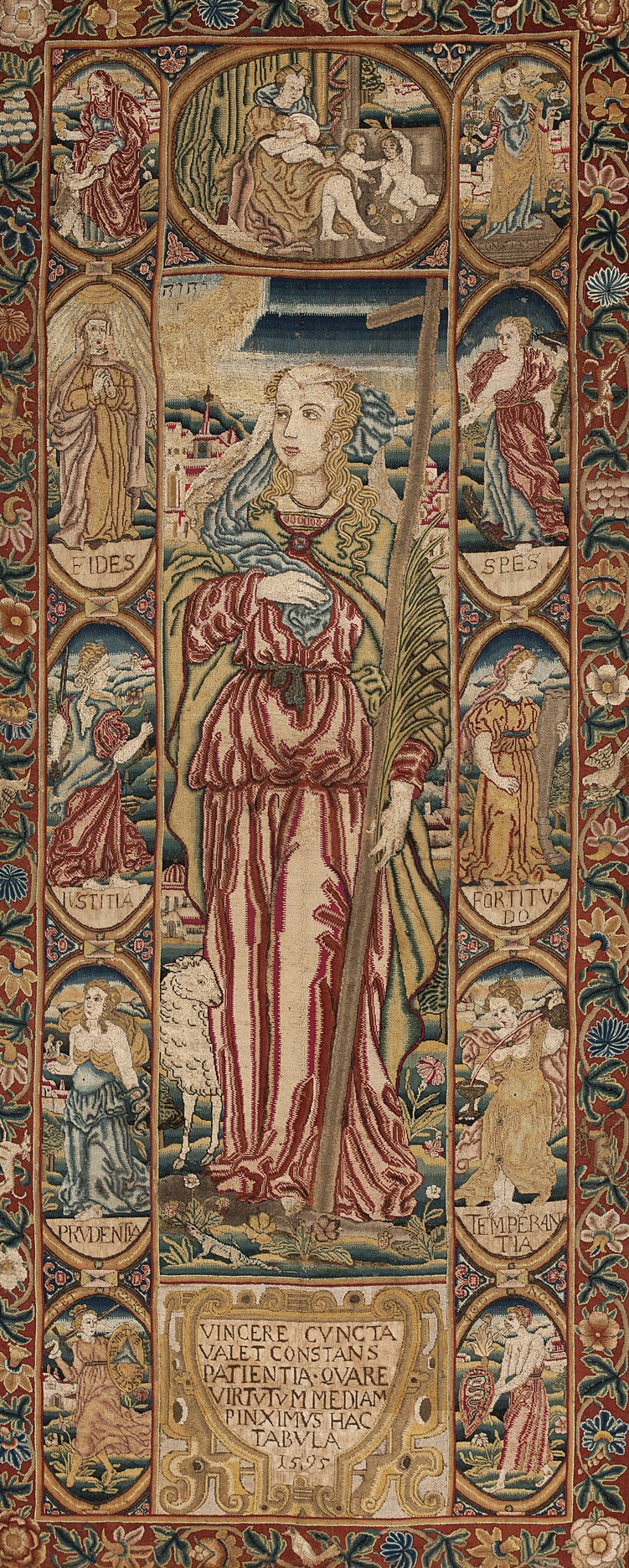
England, Patience and the seven Christian virtues, c 1595, England, wool, silk, glass beads, metal threads on linen canvas, 191.0 x 78.0 cm, 75.19″x 30.70″, Collection Art Gallery of South Australia, Adelaide
__________________
The Metrolpolitan Museum of Art (The MET): Click HERE for a succinct account of 16th century Europe’s production of tapestry – fabulously interesting from a political, social and economic point of view.
__________________
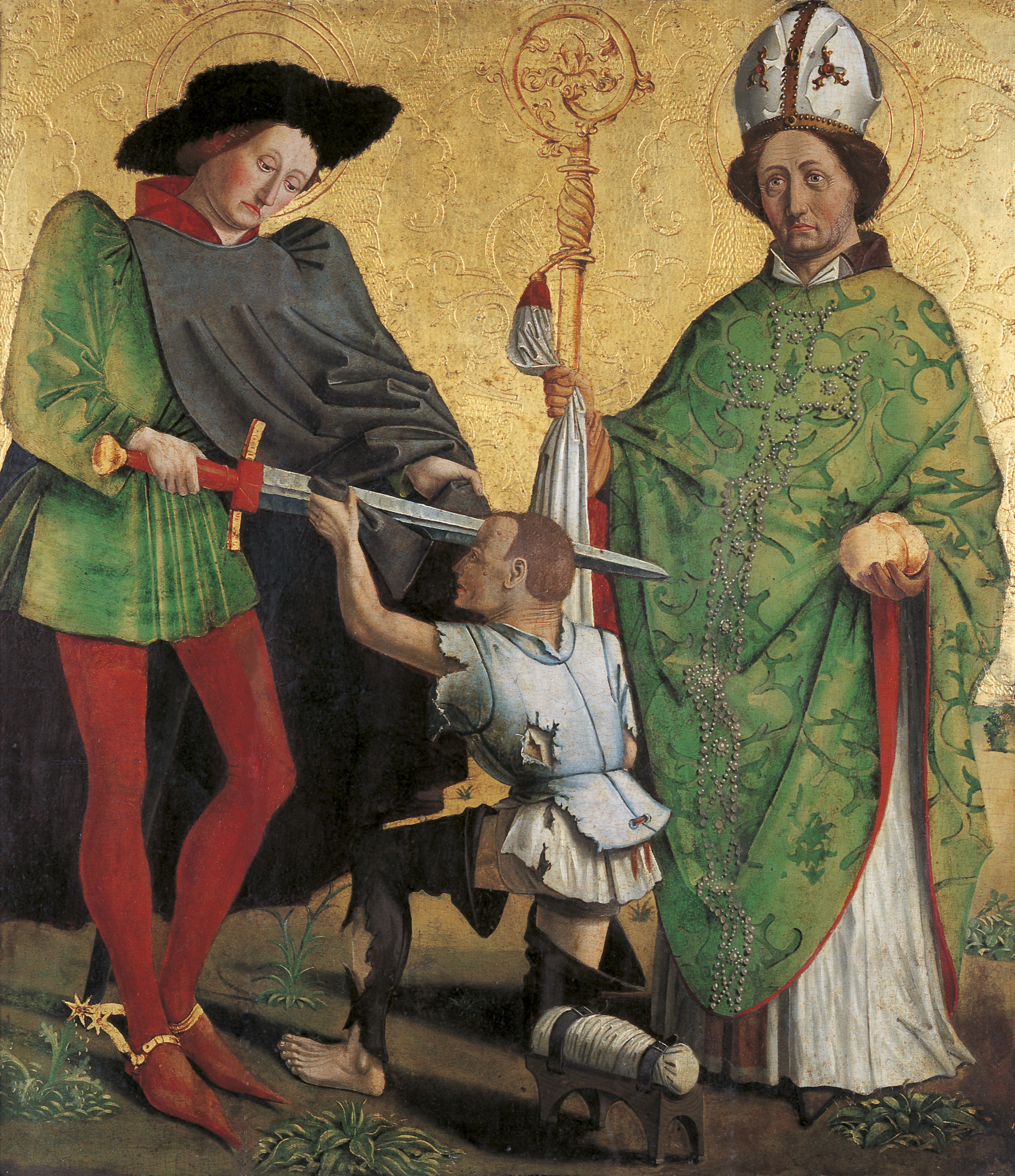
Master Of Uttenheim, born Tyrol, Austria/Northern Italy 15th century, St Martin of Tours and St Nicholas of Bari, c 1475, Pustertal, Tyrol, Austria, tempera, gold on wood panel, 76.3 x 68.0 cm, Collection Art Gallery of South Australia, Adelaide
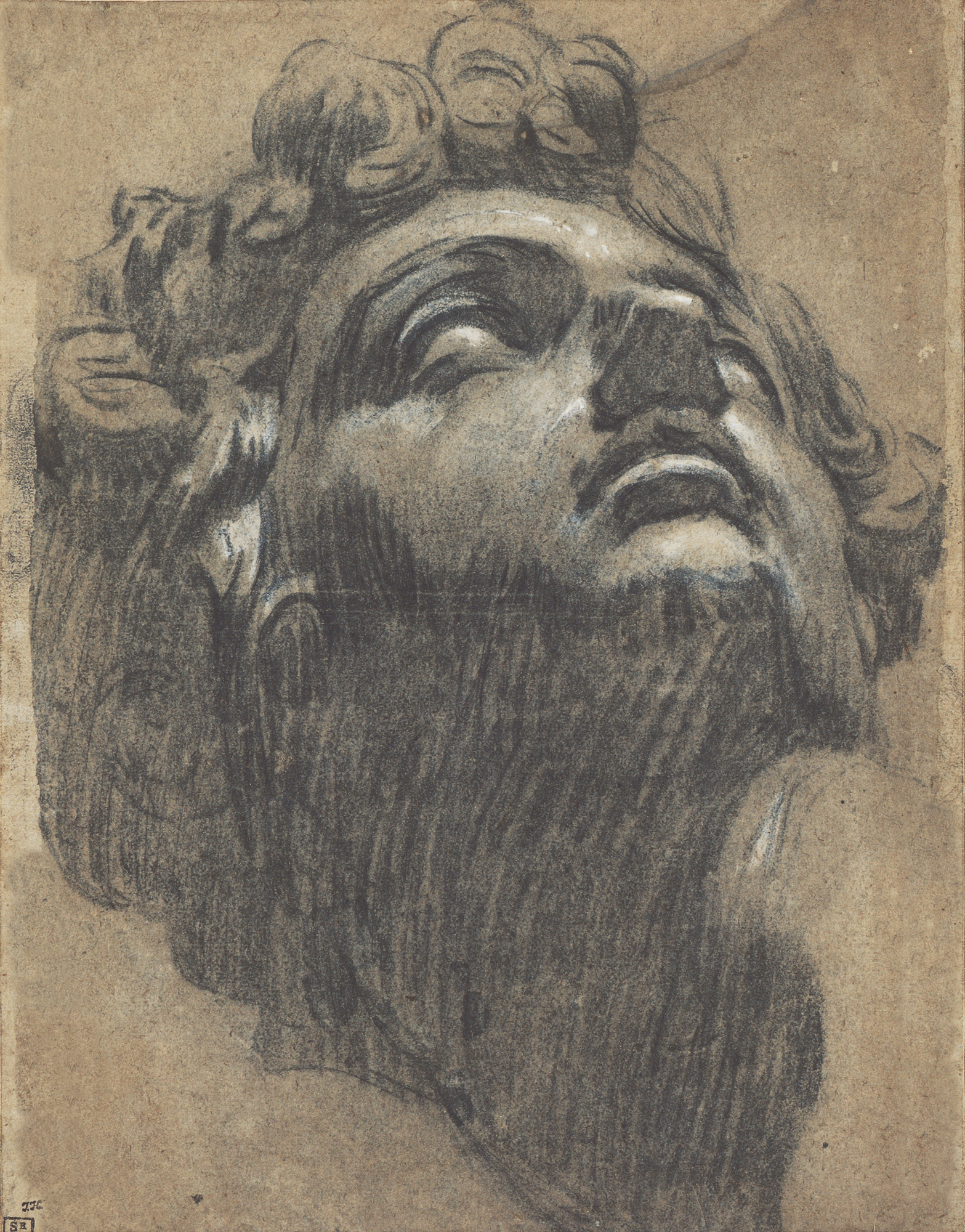
Jacopo Tintoretto, born Venice, Italy 1518, died Venice, Italy 1594, Head of Giuliano de’ Medici, 1540s, Venice, Italy, black & white chalks on brown paper, 35.3 x 27.7 cm (sheet), Collection Art Gallery of South Australia, Adelaide
__________________
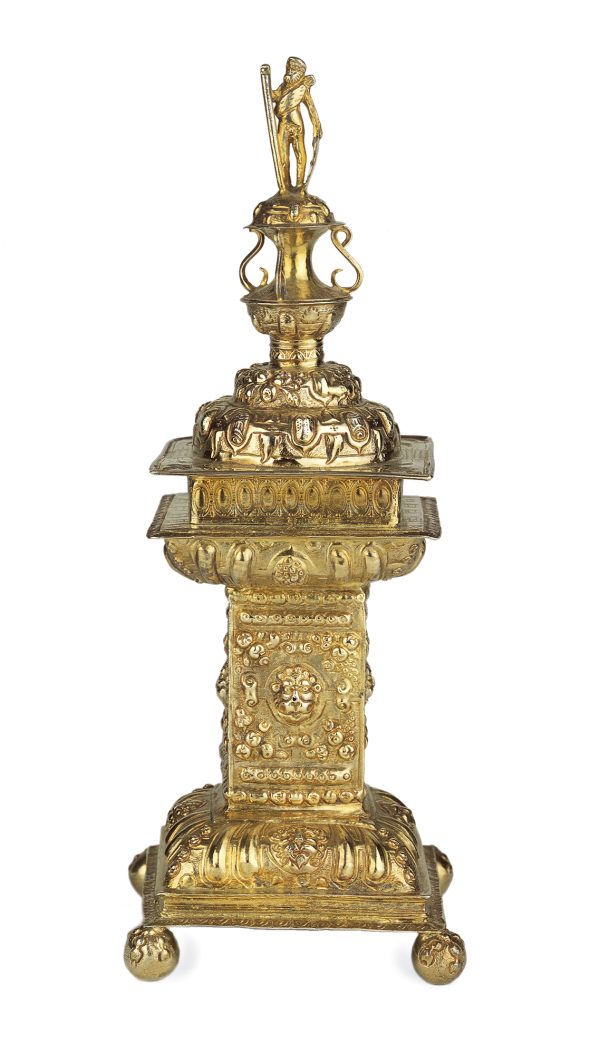
Britain, London (possibly a bull’s head maker’s mark) , Standing salt, 1583-84, London, silver gilt, 27.5 x 10.2 x 10.4 cm (10.82″ x 4.01″ x 4.09″), CollectionArt Gallery of South Australia, Adelaide
__________________
 Pieter Brueghel II, born Brussels 1564/65, died Antwerp 1637/38, The tax-collector’s office, c 1615, Antwerp, Flanders (Belgium), oil on wood panel, 74.5 x 106.5 cm, Collection Art Gallery of South Australia, Adelaide
Pieter Brueghel II, born Brussels 1564/65, died Antwerp 1637/38, The tax-collector’s office, c 1615, Antwerp, Flanders (Belgium), oil on wood panel, 74.5 x 106.5 cm, Collection Art Gallery of South Australia, Adelaide
__________________
The Tax Collector’s Office is an enigmatic work, at once rich, intricate and bustling; showing in great detail an aspect of village life. Titled The tax-collector’s office (or The Payment of the Tithe, and sometimes The Village Lawyer, because the person behind the counter wears a lawyer’s bonnet). The picture depicts the peasants gathering in the office of the tax collector to pay their tithe, usually in the form of grain. An official takes notes both on the right, and on behalf of the lawyer, for whom the peasants appear to have brought presents of goodwill, such as a chicken and eggs. The peasant’s are shown in tatty patched clothing and in postures of subservience; the waiting men have removed their hats, and gaze wide-eyed at the people in positions of power behind the desk.
Of particular note in this work is the amount of figures populating a small relatively shallow space; they are depicted in all manner of guises which highlights the degree of spatial and perspectival complexity. Additionally, the artist captures the unique and immense detail to be seen in the wads of paper, the various notes (some in tatters on the floor), the multitude of leather pouches (perhaps holding coins) and the exhaustive depiction of dress. It is well known that Brueghel II copied the work of his more famous Father, Pieter Bruegel, The Elder(2), and yet he was an expert painter in his own right: the complicated details in Tax Collector indicate a mind keen to capture scenes from everyday life to sell to the many followers and collectors of the established Bruegel tradition. He was lauded by peers Anthony van Dyck and Peter Paul Rubens who purportedly included his work in their collections.
__________________
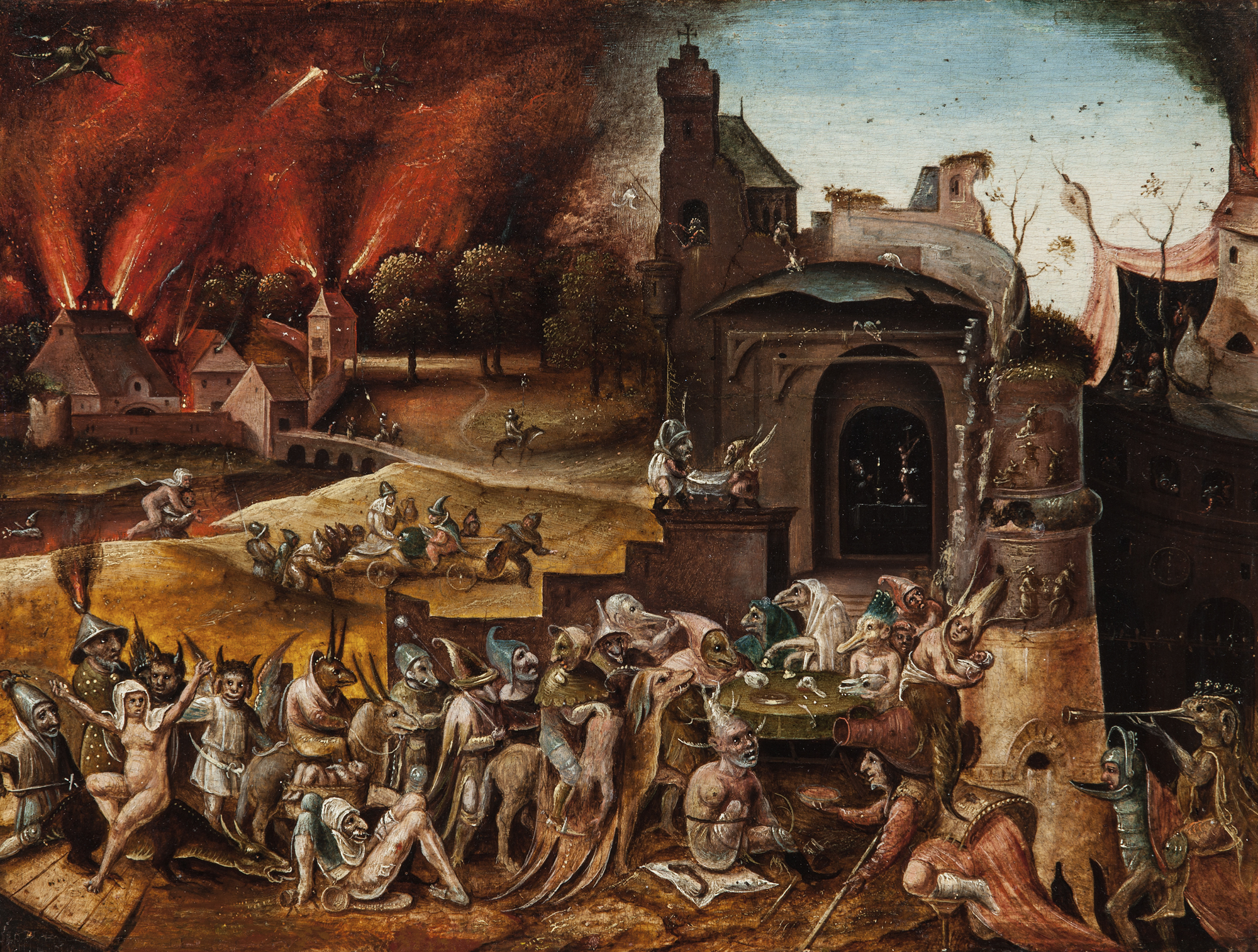
Follower of Hieronymus Bosch, born 16th century, The Temptation of St Anthony, mid 16th century, Netherlands; or Flanders (Belgium), oil on wood panel, 21.9 x 29.2 cm, 31.1 x 38.3 x 4.0 cm (frame), Collection Art Gallery South Australia
_________________
Hieronymus Bosch (1450 – 1516) is one of the Renaissance most famous painters for his The Garden of Earthly Delights, a world famous triptych that has provided the basis for lengthy interpretations and critiques across the decades on its central meaning. As a triptich, the work unfold’s left to right from the earthly paradise of Adam and Eve to damnation in hell. Pleasures or sins of the flesh feature both obviously and symbolically in the work as the conduit to a perpetual after-life in hell.
__________________
 Benvenuto Tisi, born Ferrara, Italy 1481, died Ferrara, Italy 1559, Madonna and child, c 1505-10, Ferrara, Italy, oil on wood panel, 27.5 x 23.75 cm (sight), 38.8 x 35.0 x 8.7 cm (frame); Gift of William Bowmore AO OBE through the Art Gallery of South Australia Foundation 1999, Art Gallery of South Australia, Adelaide
Benvenuto Tisi, born Ferrara, Italy 1481, died Ferrara, Italy 1559, Madonna and child, c 1505-10, Ferrara, Italy, oil on wood panel, 27.5 x 23.75 cm (sight), 38.8 x 35.0 x 8.7 cm (frame); Gift of William Bowmore AO OBE through the Art Gallery of South Australia Foundation 1999, Art Gallery of South Australia, Adelaide
__________________
There are several interesting conditions emanating from this sumptuous image. Firstly, Tisi has imbued the face of the Madonna with a wafting sense of wistfullness or perhaps melancholy, a situation enhanced by the soft palette, and the fact that her head is slightly tilted as if she is day-dreaming or lost in thought. As so often in Renaissance art the image holds more than one meaning, thus while the religious theme is obvious it is perhaps additionally, an allegory of love, or lost love. Whilst it is difficult to ascribe definitive expression to the figures, the sense of pensiveness on the face of the Virgin combined with the obvious skill of the artist in the modelling of the figures, makes possible the suggestion of a tear emerging from the Madonna’s right eye.
This aspect taken together with Cupid’s mischievious expression, the presence of the dove (a symbol of love) and the Virgin’s contemplative expression, establishes the probability that the work is an allegory of love or loss.
 Furthermore, the modelling of the figures resemble sculpture: particularly the hand of the virgin supporting the foot of the child and the white undersleeve. Paradoxically, at once soft and lustrous and yet solid – it was not uncommon for Renaissance painters to copy from statuary and therefore, imitate the finish.
Furthermore, the modelling of the figures resemble sculpture: particularly the hand of the virgin supporting the foot of the child and the white undersleeve. Paradoxically, at once soft and lustrous and yet solid – it was not uncommon for Renaissance painters to copy from statuary and therefore, imitate the finish.
The term Renaissance means ‘rebirth’ and it indicates the significant rediscovery, and subsequent interest in ancient Greek and Roman texts. ‘…the search for lost manuscripts of ancient authors, begun by Petrarch in the previous century, led to an extraordinary revival of interest in classical antiquity…’, like Virgil and Horace, as well as ancient Greek and Roman statuary. The renewal was given impetus by the discovery of a statue of Apollo in the ancient ruins of a domus on the Viminal Hill in 1489. The statue is purportedly a copy of an original bronze dating to 330BC. Christianity and the wisdom and learning of the ancient world. The opposition of the Church to classical literature did not last long…Classical literature was allegorically interpreted and Christian truth was found to lie underneath its attractive fabling.
The reinvestigation into ancient classics inevitably shone a light on Venus (Goddess of love) and Cupid (Roman God of love), (respectively Aphrodite and Eros in Greek mythology). Images of the Goddess and Cupid flood Renaissance imagery as Cupid is depicted here holding a dove, one of Venus’s attributes along with roses and myrtle. Whilst there are many visual interpretations of small chubby Cupids, putto and cherubim, variously with or without wings, bow and arrow and other symbols there is no discounting the powerful symbolism contained in this image. The Virgin is beautifully and solemnly composed with her head tilted slightly to the right, while Cupid’s head is tilted to the left gazing at the dove. There is a clear reference to love, and feasibly the beauty of the Virgin who is perhaps day dreaming about a lost love, or lost in thought over a current love. Cupid, is both routinely shown with a mischievious expression and with doves, as is his Mother, the Goddess Venus.
__________________
Featured image: Benvenuto Tisi, born Ferrara, Italy 1481, died Ferrara, Italy 1559, Madonna and child, c 1505-10, Ferrara, Italy, oil on wood panel, 27.5 x 23.75 cm (sight), 38.8 x 35.0 x 8.7 cm (frame); Gift of William Bowmore AO OBE through the Art Gallery of South Australia Foundation 1999, Art Gallery of South Australia, Adelaide
________________
__________________
(1)Due to the fact that I am passionate about history and art, I couldn’t resist sharing Giovanni Bellini’s San Zuccaria Alterpiece and the San Zuccaria church.
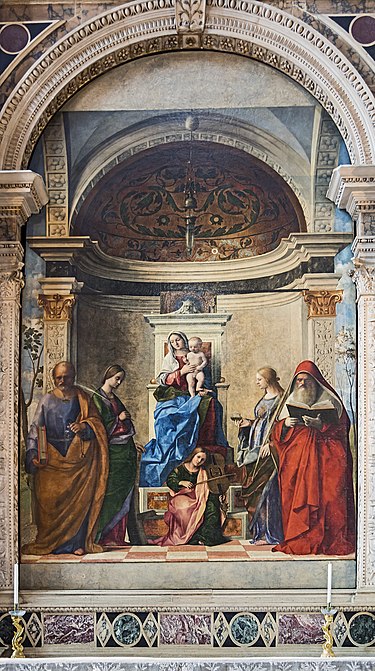
Image courtesy of Wikipedia
Giovanni Bellini, San Zaccaria Altarpiece, (also called Madonna Enthroned with Child and Saints), 1505, oil on wood transferred to canvas, 16′ 5-1/2” x 7′ 9” (5.02 x 2.40cm) (San Zaccaria, Venice).
Here Bellini displays his mastery of perspective, modelling and the depiction of light: it was one of his finest and last alterpieces.
“The subject of the altarpiece is a sacred conversation (sacra conversazione), a type of painting that developed first in Florence and then in Venice. The sacred conversation describes a subject of the enthroned Virgin, holding the infant Christ, surrounded by standing saints of differing eras, accompanied by angels. All of the figures are united in a single space.”
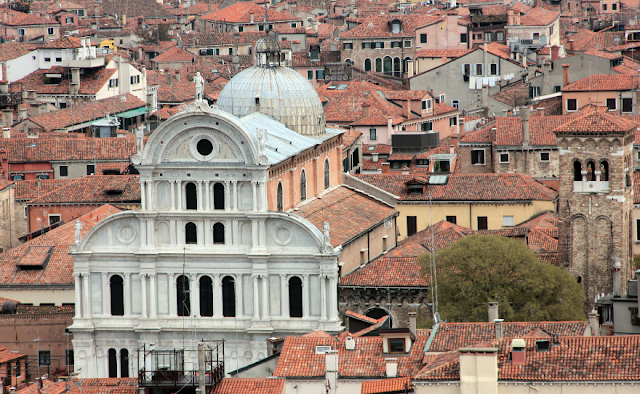
Image courtesy of the Liturgical Arts Journal
“The church of San Zaccaria, represents a combination of architectural elements: gothic, early Renaissance, Byzantium and Romanesque. San Zaccaria dates to the fifteenth century, with construction beginning in 1458 and finalisation around 1500. It was not the first church on this site however, replacing an earlier church dating to the ninth century: it sits next to the newer church…The church houses the relics of St. Zachary, father of St. John the Baptist, which had been gifted to Venice by the Byzantine emperor Leo V. The church also has a strong connection to the doges of Venice.”

Image courtesy of the Liturgical Arts Journal
__________________
(2) At the University of Auckland I worte a thesis on Ernst Gombrich as part of completing a Masters in art history. My supervisor for the thesis was Iain Buchanan (1948 – 2018). He wrote a number of publications on the Renaissance particularly on Northern art and tapestry, one of which is the Habsburg Tapestries. At the time of his death, Iain was working on a book which examines the paintings of Pieter Bruegel in relation to the collecting and marketing of art in sixteenth century Antwerp. An international expert in Northern Renaissance Art, Iain Buchanan had over 40 years of experience in research, teaching and publication in his field. He gave me two pieces of advice I have never forgotten; they routinely hover at the margins of my thought processes: “There is only one person in the world with your views, so don’t be afraid to have an opinion; your opinion is unique.” And, he perpetually reminded me that history is always viewed through the lens of the present day (whenever that present day happens to be), so invariably whomever is the viewer of that history will be doing so through the lens of the dominent influences they are subjected to at that time. He remains a great loss to art history.































